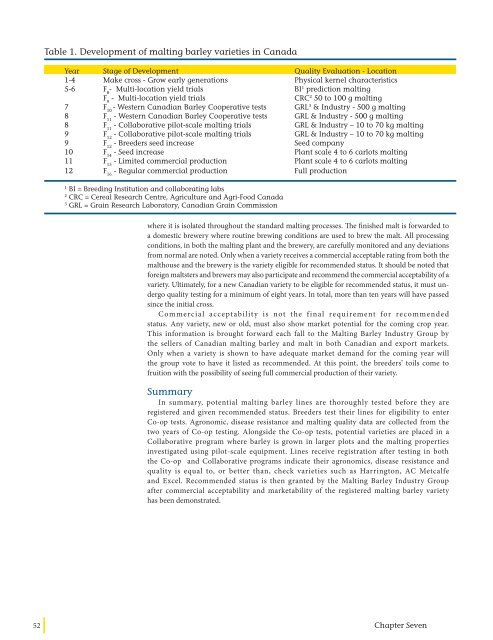MALTING QUALITY TRAITS - Canadian Malting Barley Technical ...
MALTING QUALITY TRAITS - Canadian Malting Barley Technical ...
MALTING QUALITY TRAITS - Canadian Malting Barley Technical ...
Create successful ePaper yourself
Turn your PDF publications into a flip-book with our unique Google optimized e-Paper software.
Table 1. Development of malting barley varieties in Canada<br />
Year Stage of Development Quality Evaluation - Location<br />
1-4 Make cross - Grow early generations Physical kernel characteristics<br />
5-6 F 8 - Multi-location yield trials BI 1 prediction malting<br />
F 9 - Multi-location yield trials CRC 2 50 to 100 g malting<br />
7 F 10 - Western <strong>Canadian</strong> <strong>Barley</strong> Cooperative tests GRL 3 & Industry - 500 g malting<br />
8 F 11 - Western <strong>Canadian</strong> <strong>Barley</strong> Cooperative tests GRL & Industry - 500 g malting<br />
8 F 11 - Collaborative pilot-scale malting trials GRL & Industry – 10 to 70 kg malting<br />
9 F 12 - Collaborative pilot-scale malting trials GRL & Industry – 10 to 70 kg malting<br />
9 F 12 - Breeders seed increase Seed company<br />
10 F 14 - Seed increase Plant scale 4 to 6 carlots malting<br />
11 F 15 - Limited commercial production Plant scale 4 to 6 carlots malting<br />
12 F 16 - Regular commercial production Full production<br />
1 BI = Breeding Institution and collaborating labs<br />
2 CRC = Cereal Research Centre, Agriculture and Agri-Food Canada<br />
3 GRL = Grain Research Laboratory, <strong>Canadian</strong> Grain Commission<br />
where it is isolated throughout the standard malting processes. The finished malt is forwarded to<br />
a domestic brewery where routine brewing conditions are used to brew the malt. All processing<br />
conditions, in both the malting plant and the brewery, are carefully monitored and any deviations<br />
from normal are noted. Only when a variety receives a commercial acceptable rating from both the<br />
malthouse and the brewery is the variety eligible for recommended status. It should be noted that<br />
foreign maltsters and brewers may also participate and recommend the commercial acceptability of a<br />
variety. Ultimately, for a new <strong>Canadian</strong> variety to be eligible for recommended status, it must undergo<br />
quality testing for a minimum of eight years. In total, more than ten years will have passed<br />
since the initial cross.<br />
Commercial acceptability is not the final requirement for recommended<br />
status. Any variety, new or old, must also show market potential for the coming crop year.<br />
This information is brought forward each fall to the <strong>Malting</strong> <strong>Barley</strong> Industry Group by<br />
the sellers of <strong>Canadian</strong> malting barley and malt in both <strong>Canadian</strong> and export markets.<br />
Only when a variety is shown to have adequate market demand for the coming year will<br />
the group vote to have it listed as recommended. At this point, the breeders’ toils come to<br />
fruition with the possibility of seeing full commercial production of their variety.<br />
Summary<br />
In summary, potential malting barley lines are thoroughly tested before they are<br />
registered and given recommended status. Breeders test their lines for eligibility to enter<br />
Co-op tests. Agronomic, disease resistance and malting quality data are collected from the<br />
two years of Co-op testing. Alongside the Co-op tests, potential varieties are placed in a<br />
Collaborative program where barley is grown in larger plots and the malting properties<br />
investigated using pilot-scale equipment. Lines receive registration after testing in both<br />
the Co-op and Collaborative programs indicate their agronomics, disease resistance and<br />
quality is equal to, or better than, check varieties such as Harrington, AC Metcalfe<br />
and Excel. Recommended status is then granted by the <strong>Malting</strong> <strong>Barley</strong> Industry Group<br />
after commercial acceptability and marketability of the registered malting barley variety<br />
has been demonstrated.<br />
52 Chapter Seven


